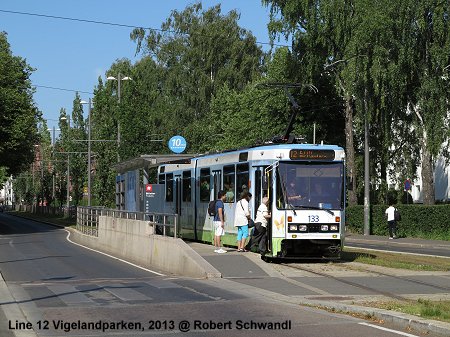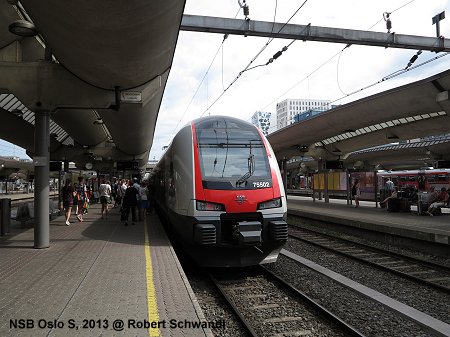The
last stop on my extensive Scandinavian tours this summer was
Copenhagen, a place I had also been before several times, and since
my last visit in 2007 not too many things have changed. In that year
I was there in July, and the Metro's Airport extension only opened in
September, so that was new to discover for me during this year's
visit (31 Aug - 3 Sept 2013). But as expected, it didn't really have
anything new about it as the stations are pretty identical to the
older ones. On this new section, there was a bad choice of station names. I observed a group of youngsters who were not sure whether they had to get off at "Kastrup" to get to the Airport or not, as in the region "Kastrup" seems to be synonymous for airport, like Heathrow or Barajas. In Malmö, Öresund trains are actually labelled as "Kastrup/Københamn", so the metro terminus should be called like the Öresund station, i.e. "Københavns Lufthavn Kastrup", while the current metro station called "Kastrup" should either have an appendage like "village" or better be called something else completely to avoid confusion.
Starting
my exploration on Saturday morning, I was pretty shocked to find a
rather dirty Metro system. I had seen it quite new and shiny
in 2003 and still in 2007 it looked good, but now it is showing its
age (well, only 11 years!). Getting on a train after a Friday night
service, when apparently the trains are used for partying, did not
help to get a positive impression. But besides the fresh dirt left
behind by the partying folk, the seats look completely worn-out and
wasted, the creamy cladding looks dirty especially in the gaps
between those panels as if noone has ever cleaned the trains more
thoroughly for years. There are cleaners at least at the Vanløse
terminus who take away the litter, but the nonstop service doesn't
seem to allow proper cleaning, although not all trains are in
operation during night times. The stations still look quite alright,
although also the corners and edges on the stairs could take some
high-pressure waterjet cleaning. The outside of the trains still
looks quite o.k., no graffiti, but the white livery, just like in
Oslo, starts to look pale and dirty after some years.
The
S-tog is quite the contrary, the trains look rather clean
inside (the dim light helps to make them look better...), but many
are redecorated with huge graffiti and many stations have become
simply pathetic, notably Nørrebro, all painted with graffiti and
also pretty neglected otherwise. Apparently, they don't have enough
trains to withdraw the painted ones from service. I hope they are not
going the same way into disaster as the Berlin S-Bahn did after
cutting investment and jobs!
Generally,
however, I like both Metro and S-tog. The S-tog is almost like a
metro, running frequently, and with these super-wide trains. All the older trains have been retired since my last visit. A few
years ago they simplified the system, but now they made it more
complicated again by simplifying the weekend service. But this
'simplification' results in 3! different system maps placed next to
each other on the trains, one for normal weekday service, one for
weekend daytime service, and yet another for weekend night service!
And all three displayed in the same size. I wonder if this is really
necessary? I like the strong image of the S-tog with its huge logo,
and everyone perceives the system as something different from other
local and regional trains, while in Oslo or Helsinki there this
distinction is very vague.
What
I like about the Metro is that it is well-built. Unlike the Canada
Line in Vancouver, the alignment is perfect, so trains can go into
curves at full speed and very elegantly - and I'm looking forward to
the Cityring as it almost exclusively consists of curves, so that
will be fun to ride. Interestingly, trains start to shake a bit on
the straight elevated sections! And, unlike Stockholm, the trains are perfectly tuned, they accelerate and slow down at the right speed, very smoothly and without the danger of passengers falling. The basic design of the stations
looks nice, but boring, as all are the same. But luckily, I'm not the
only one who criticizes that and therefore the new stations on the
circular line will be quite colourful, e.g. red if they provide
interchange with the S-tog. I think it would have been wiser to
arrange the two flights of double escalators in a different way. The
way they are laid out now, all passengers getting off a train need to
walk to one end of the platform where they find two sets of
escalators going up. I think passenger flow would be better if there
was one escalator going up from either end of the platform. Anyway,
what is completely missing are the escalators from the mezzanine to
street level, instead there are only stairs which are extremely
steep, the steepest I have ever seen anywhere on a public transport
system. Luckily, the present entrance at the busy Kongens nytorv
station right in the city centre will be replaced by a new entrance
anyway in conjunction with the new ring line. Many passengers
therefore rather wait for the lift to get to the surface directly. I
think stations should have been made more future-proof from the
start, but many of them in the central area already appear too small
for the crowds they have to handle. This is a common misunderstanding
nowadays, that driverless metros can be built with small stations.
But if in the end you get a train every 90 seconds or less on each
side, the small platforms at Nørreport or Kongens nytorv will have
problems absorbing all those passengers getting off and at the same
time handle those boarding. Adding a fourth car will just make the
overcrowding worse. Also, centrally located stations like Kongens
nytorv should by definition have exits in different directions to
disperse passengers and increase the catchment area.
Unless
there is an agreement soon, the new metro station at the Central
Station will be quite a disaster. It is being built at the "back"
side of the railway station, which as such is not bad. But as of now,
it will not be directly accessible from the railway station, instead
it will be a standard station with only one exit in a small street
nearby that actually faces away from the railway station. So, please,
DSB and Metro, get your act together and build a proper interchange,
otherwise the whole world will laugh at you both! At Nørreport, the
interchange is actually being enlarged right now, adding a new
entrance on the city centre side (let's hope that the busy, but
appalling Nørreport S-tog station will also be upgraded soon!).
What
I like least about the Copenhagen transport system is its lack of a
common transport authority. Luckily all tickets are valid for all
different operators, but there is no face to it all. Except for some
security people, the Metro is completely unmanned, no visible
information office, just machines and a few info leaflets in some
stations, the same is true for the S-tog, and I don't know about
Movia who operates the buses. This is the absolute contrary to
Stockholm, where SL is omnipresent, has a few customers offices in
strategic places and with many metro stations staffed. At least the
tourist office has some maps for visitors which also explain the fare
system a bit.
Which
brings us to Copenhagen's excessive zonal fare system. The capital
region where all those shared tickets are valid may be similar to
SL's territory in Stockholm. And while SL needs 3 fare stages (for
single tickets only - one single fare zone for all other tickets),
the Copenhagen area is divided into none less than 95!!! zones. The
maximum number of zone you need to pay is 9. Visitor's passes sold as
"City Pass" can be found on machines under "City
centre tickets", although they cover zones 1-4 which also
includes the Airport, so that's pretty misleading, too. Luckily, many
maps show the different zones, although at S-tog stations, I wasn't
sure whether Hellerup was included in this type of ticket or not (in
the end it is in two adjacent zones, but that was badly drawn). On
the other days I bought a 24-timers
billet (24-hour ticket) which is valid in all zones, but costs some
17.50 EUR but at least you don't have to bother about zones when
taking the S-tog a bit beyond the half-circular F line. Travelling in
the region over the Öresund Bridge into Sweden can also be tricky as
explanations on the different websites are not very clear. I bought a
day-return ticket from Copenhagen to Malmö and understood that this
includes travel on local buses for 24 hours also in Malmö. I cannot
confirm that this is true, as when I showed my paper ticket to the
bus drivers, they didn't really look at it, as on that day the
electronic ticketing system in Malmö was not working anyway and they
simply didn't care about tickets.... But I think they never look at
them as you cannot really expect that all bus drivers know all the 95
fare zones on the Danish side plus their 100+ zones on the Swedish
side.
Talking
of Malmö, I did, of course, its small underground system, opened in
2010 as Citytunneln, with two underground stations and one partly
covered station (Hyllie). While the underground station at Malmö
Central is quite typical for European railway stations built in the
last two decades, the tube station at Triangeln at the southern edge
of the city centre is quite pleasant with clear lines, good
visibility despite the massive row of columns in the middle. The
route is frequently served by Öresund trains from Copenhagen at
least every 20 minutes plus some of those purple Pågatåg services
operating in Southern Sweden, but there is no regular headway between
trains, so there may be longer gaps.
LINKS


































